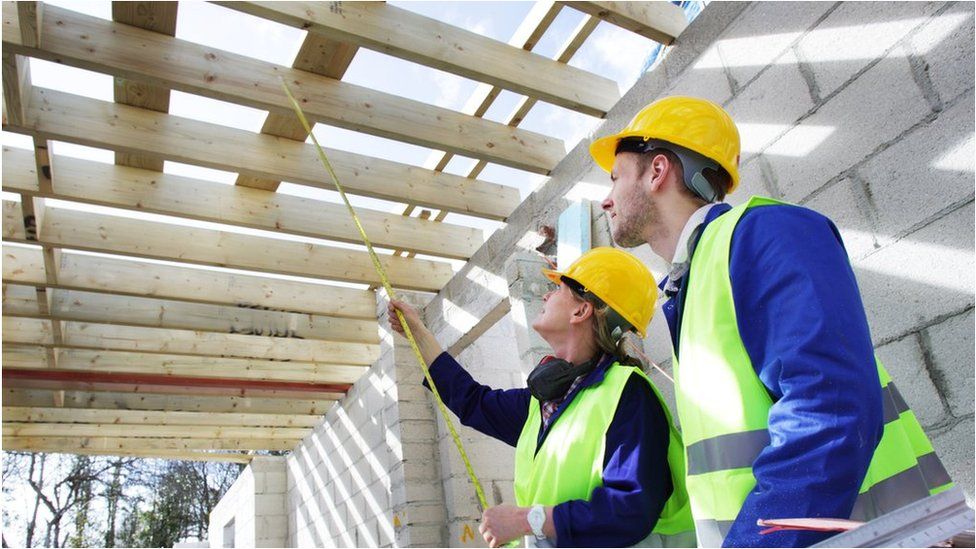New homes: What's happened to the government's housebuilding target?
- Published

The latest housebuilding figures show the government has not yet met its annual target to build 300,000 new homes in England.
In July, the Levelling Up Committee of MPs warned that the government was not on track to meet the target, but said it might still fulfil its other goal to build one million homes during this Parliament.
What is the government's housebuilding target?
The target, set out in the 2019 Conservative manifesto, is for "300,000 homes a year by the mid-2020s".
The figure, which is for England, was unveiled by then-Chancellor Philip Hammond in November 2017.
"Experts agree that 300,000 new homes a year would start to make inroads on the affordability of housing," he told BBC News at the time.
The manifesto also pledged to build at least a million more homes by the end of this Parliament, which will be December 2024 at the latest - five years since the current Parliament first sat.
The government also proposed changes to the planning system to help build more houses, but was accused of watering these down after some Conservative MPs threatened to rebel.
Prime Minister Rishi Sunak had been trying to introduce binding targets for local councils, but the government said: "Housing targets remain, but are a starting point, with new flexibilities to reflect local circumstances."
How close has the government come to meeting its targets?
In 2019-20 there were 248,591 "net additional dwellings", but this fell to 217,754 in 2020-21, partly due to the pandemic.
In both 2021-22 and 2022-23 the figures were just under 235,000 a year.
"Net additional dwellings" is the headline figure for housebuilding, and includes houses being converted to flats or commercial buildings switching to domestic use, as well as new builds. It also reflects demolished houses.
"The government will miss [its] 300,000-homes-a-year manifesto pledge by a country mile," former Housing Secretary Robert Jenrick told MPs on 10 May 2022.
He predicted that 2019-20 total of 248,591 would be "the high watermark of the number of homes built in this country for several years to come".
In terms of the target of building one million homes during this Parliament, 935,204 additional homes have been built in England since April 2019.
However, that overstates the total, as this Parliament did not begin until 19 December 2019.
The total built since April 2020 is 686,613, although this ignores houses built between December 2019 and March 2020.
How many homes were being built previously?
On average, almost 250,000 homes were built in England in each year of the 1970s.
But there was also a great deal of demolition, largely due to slum clearance, which made the overall net figure just under 200,000 a year.
The 1990s saw many fewer homes built but also fewer demolitions, taking the overall average to about 150,000 a year.
This annual figure then rose until the 2007-08 financial crisis, when housebuilding stalled, before recovering in the mid-2010s.
What is the government doing to boost housing affordability?
Even hitting the annual target wouldn't necessarily address the current housing shortages if they are the wrong sort of properties, according to housing charity Shelter.
"There is no point in building 300,000 homes a year if the vast majority are overpriced flats and houses that people on average or lower incomes can't afford," it said.
"The government must make sure any target it sets will deliver the genuinely affordable social homes this country needs."
The government's 2020 Social Housing White Paper renewed its affordable-homes commitments for 2021-26.
An £11.5bn programme is supposed to deliver up to 180,000 new homes over that period, half offering affordable ownership and half offering discounted rent.
The government's latest figures on affordable-housing supply show 63,605 affordable homes were completed in England in 2022-23, an increase of 7% from the previous year.
These homes are classified as having:
- affordable rent - properties rented by local authorities or other providers at up to 80% of local market rent
- London affordable rent - a separate classification, offered by the Greater London Authority, also capped at 80%
- social rent - affordable housing usually owned by local authorities and housing associations with rents set by a national rent formula
- intermediate rent - rent capped at 80% for key workers, sometimes as part of a scheme to help save up to buy a home
- shared ownership - purchaser buys between 25% and 75% of a home and pays rent on the remaining share
- affordable home ownership - homes offered at no more than 80% of local market values
How much have house prices risen?
When Mr Hammond announced the 300,000-a-year target in November 2017, the UK average house price was £224,453, according to the Office for National Statistics (ONS).
The latest figures for September 2023 show an average price of £291,385, an increase of 30%.
For comparison, over the same period, the consumer price index (CPI) measure of inflation has risen by 26%.
